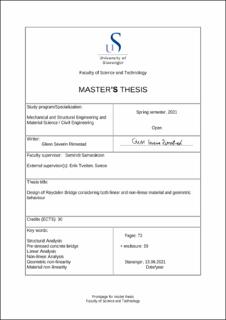| dc.description.abstract | Traditional design of reinforced concrete structures is based on the assumption of linear elastic behaviour of concrete and steel, even though the materials behaviour rarely is linear in reality. This thesis compares the required reinforcement of Røydalen Bridge when designed for linear versus non-linear material and geometrical behaviour.
The prestressed concrete bridge was completed in 2019 as a part of the highway E18 at the south coast of Norway. Modelling, analysing and design was performed in the FEM software Sofistik by the engineers that today are employed at Sweco of which the thesis is written in collaboration with.
Firstly, knowledge about the main subjects was gained as preparations for the analyses. A literature review was conducted to better understand non-linear analyses and material behaviour. Methods of analyses and design guidelines was catalogued to properly perform and understand the later work. Simultaneously, the learning of Sofistik was initiated through learning exercises and modelling.
Sofistik is an advanced FEM software which are particularly directed at structural and civil engineering. The software is composed in a modular structure that enables solutions of complex and advanced problems through several methods, including pre-defined, graphical and coding user interfaces. As the software is accommodated for traditional analysis, constructing and performing the linear analysis proved unproblematic. Sofistik automatically returns the design load combinations if coded correctly. Global non-linear analyses are normally not conducted, which was obvious as the information was sometimes insufficient and unclear. During configuration, a limitation of pre-stressed concrete beam-elements in the software was discovered. As a result, the objective was altered from the whole bridge to only the columns.
The software does not automatically return the non-linear design load combinations, as the principle of superposition is not valid. This meant that 1539 individual load combination was to be performed per analysis. After constructing the whole analysing code through Visual Studio, each analysis consisted of 32 337 written lines. As the structure is checked for SLS, ULS a and ULS b, 97 011 written lines was required to perform the non-linear analyses. In the end, each non-linear analysis consumed approximately 48 hours to perform.
Non-linear behaviour proved to require less reinforcement than linear. In critical sections, the difference was substantial, ranging from 21 to 49% and at most 33 Ø20 bars. Total accumulated required reinforcement was minimal, however.
The combination of material and geometrical non-linearity formed a ductile structure with constantly changing stiffness matrix (or E-modulus). As the structure deforms, inferior internal forces are required to withstand the applied loads, compared to the linear analysis that are not allowed to deform. The ductile behaviour, hence, the lesser internal forces, explains the difference in required reinforcement. However, as the concrete is a brittle material, the linear analysis is more compatible with its characteristics. The reinforcement provides capacity in tension, but with the non-linear combination, yielding occurs at a lower stress and strain stage.
With the simplicity and degree of accuracy in linear analysis, the complex non-linear global analyses cannot be justified if linear analyses are applicable. The linear analyses require more reinforcement but provides a more secure and compatible behaviour to the concrete’s brittle characteristics. | |
